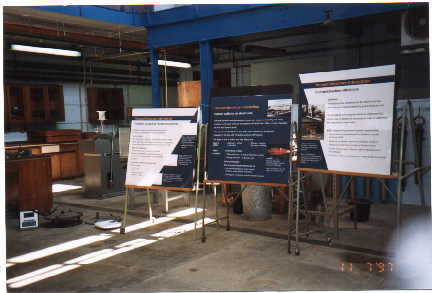DEMONSTRATION AND MEASUREMENT OF THE HUMAN
WHOLE-BODY EFFECTS IN STRUCTURAL VIBRATION
![]() Research Papers from the Project
Research Papers from the Project


The demonstration site and the test rig in the Department of Civil and Structural Engineering, UMIST
How people interact with their environment is a topical issue. One form of physical interaction which is understood poorly, even by professionals, is concerned with human response to vibrations in structures. This is important for instance when determining how dance floors or grandstands respond to crowds of moving people and when determining how people in stationary are affected by vibration in their home and working environment. Some aspects of human-structure interaction have been investigated by Dr. B. R. Ellis and Dr. T. Ji[1] who have identified that during such interaction the human body acts as a mass-spring-damper rather than as an inert mass in a vibrating environment. This project is made to enable the construction of a simple test rig and to demonstrate the phenomenon of human-structure interaction.
The test rig proposed is simple and comprises a steel plate supported by several springs. The test itself is simple and quick, but the results are intriguing and unlikely to be anticipated in advance. The natural frequency of the test rig is first measured. A weight is added to the rig and the natural frequency is again measured and will be found to be lower than before. The weight is removed and a person is invited to stand on the rig when the natural frequency is again measured. This time the natural frequency will be higher than that of the test rig along. It is apparent from the test that a person does not act as a simple ‘weight’ (mass), but rather the flexible human body interacts with the structure and can absorb energy. From the test the fundamental frequency of the person can be obtained.
The purpose of demonstrating the test is to introduce people to a new area of science which affects them directly and to show how they interact physically with an aspect of their environment. In addition to the educational and fun aspects of the test, valuable scientific data will be gathered over a period of time which will be used to develop a further understanding of characteristics of the human body, something which affects everyone.
Display boards will be produced to provide background information for observers/participants of the tests and these will be updated as more information is produced.
[1] Ellis, B. R. and Ji, T.,(1997), Human-structure interaction in vertical vibrations, Structures and Buildings, the Proceedings of Civil Engineers, Vol. 122, No.1, pp.1-9
The test rig has been built and used in several occasions to demonstrate human the whole-body effects in structural vibration. The phenomenon of the human whole-body acts as mass-spring-damper rather than a mass was demonstrated by measuring and comparing the frequencies of the test rig with and without a person standing on it. The demonstration has been conducted in the following events:
29 May 1997: Insight into Engineering
19 June 1997: Insight into Engineering
30 June 1997: Headstart
1 July 1997: Headstart
25 Sept. 1997: New Students in the Dept.
26 Sept. 1997: New Students in the Dept.
24 June 1998: Steel Construction Week
The visitors included school science teachers, engineers, UCAS applicants and University students.
Research Papers from the Project